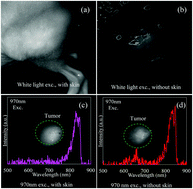Highly efficient NIR to NIR upconversion of ZnMoO4:Tm3+,Yb3+ phosphors and their application in biological imaging of deep tumors†
Abstract
ZnMoO4:Tm3+,Yb3+,K+ nano-phosphors with intense NIR to NIR (excitation by 980 nm, emission at ∼800 nm) upconversion were synthesized by a facile hydrothermal method. The nanoparticles were of the order of 200–400 nm. The XRD patterns confirmed a single phase triclinic structure despite doping small amounts of RE3+ and alkali ions. The optimum concentration of Tm3+, Yb3+ and alkali ions were determined to be 0.1 mol%, 10 mol% and 10 mol%, respectively. Besides charge neutrality, the doped K+ ions affected the crystal field symmetry around the Tm3+ ions which increased the f–f transition probabilities of the RE3+ ions, and hence increased the UC intensities. Compared with ZnMoO4:Tm3+,Yb3+, the NIR to NIR upconversion emission intensity of 10 mol% K+ substituted ZnMoO4:Tm3+,Yb3+ nanocrystals increased by 21-fold and can be pumped by less than 1 mW laser power. The brightest ZnMoO4:Tm3+,Yb3+,K+ nano-phosphor was applied for non-invasively visualizing the tumors in nude mice and successfully detected deep tumors in the thigh muscles. So far, this is the first report of oxide based UCNPs used for in vivo NIR-to-NIR biological imaging and opens the door to the possibility of achieving improved features using non-fluoride based UCNPs.

- This article is part of the themed collection: JMC B Editor’s choice web collection: ‘‘seeing the unseen updated: advances in bioimaging’’

 Please wait while we load your content...
Please wait while we load your content...